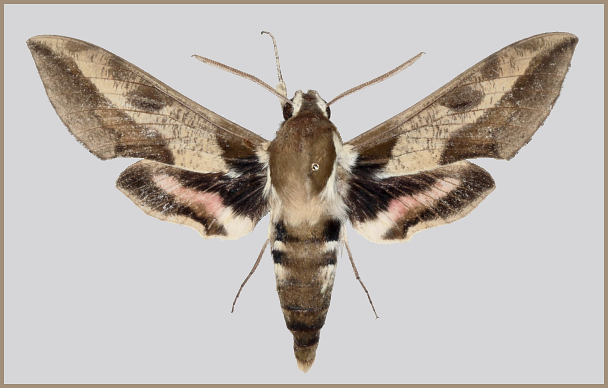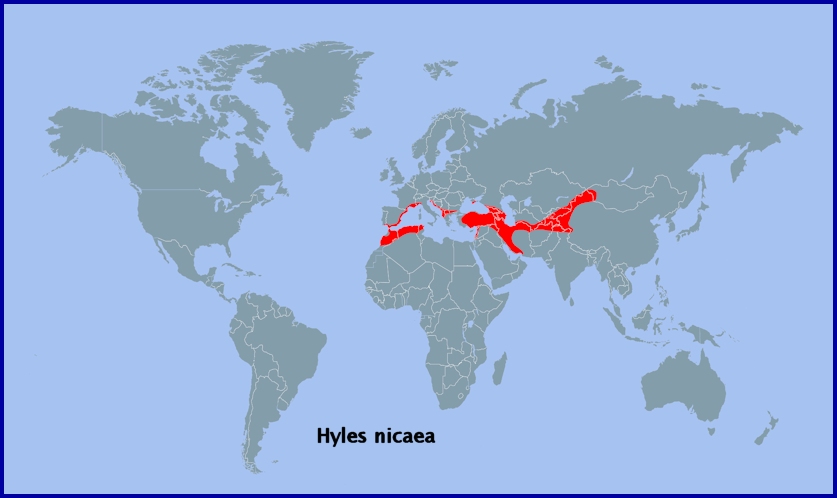UK: Greater Spurge Hawkmoth; Mediterranean Hawkmoth, F: Sphinx Nicéa; Sphinx de Nice; Sphinx de l'Esule, D: Riesenwolfsmilchschwärmer; Großer Wolfsmilchschwärmer, RUS: Nitstskii Brazhnik, H: görög szender, E: esfinge mediterranea, FIN: Välimerenkiitäjä, HR: sredozemni ljiljak.
Deilephila lathyrus Walker, 1856, List Specimens lepid. Insects Colln. Br. Mus. 8: 172.Type locality: Northern India.
(Taxonomic note. (i) Synonymized with Dilephila [sic] euphorbiae by Hampson, [1893], Fauna Brit. India 1: 98. Reinstated as a geographical variety by Staudinger, 1901, in Staudinger & Rebel, Cat. Lepid. Pal. Faunen. 1: 103. Synonymized with Celerio nicaea as a subspecies by Rothschild & Jordan, 1903, Novit. zool. 9 (suppl.): 727.
Taxonomic note. (ii) Apart from size and having more individuals with dark speckling, this subspecies has no clear characters separating it from subsp. nicaea (de Prunner, 1798) and subsp. sheljuzkoi Dublitzky, 1928, so it may well be only a form of subsp. nicaea.)
Holarctic; western Palaearctic region. Pleistocene refuge: Monocentric -- northern section of Sindian refuge.

Wingspan: 80--100mm. Variable both in size and in the amount of dark markings on the forewing.
Occurs on dry, almost desertic, stony slopes at high altitudes, usually between 3600 and 4000m altitude in Ladakh, Jammu & Kashmir, India (Smetacek & Kitching, 2012).
Only recorded from mid June to mid July, indicating a single generation.
OVUM: As subsp. nicaea.
LARVA: As subsp. castissima (Austaut, 1883). In some areas of Jammu & Kashmir/Ladakh, India, where Euphorbia stracheyi grew singly, larvae of Hyles nicaea lathyrus were found in all instars. However, some valleys with scattered plants did not yield a single larva. Where they did occur, larvae were not rare, with one larva being discovered on perhaps every ten plants examined, but in one place where the plants could be described as growing gregariously, not a single larva was found, although more than a hundred plants were examined. The noteworthy point was that each plant generally supported only a single larva, whatever its stage of development (Smetacek & Kitching, 2012).
Hostplants. Herbaceous Euphorbia spp., with Euphorbia stracheyi recorded from Leh, Ladakh, Jammu & Kashmir, India (Smetacek & Kitching, 2012).
PUPA: 45--50mm. Identical to that of subsp. nicaea. Pupates in a chamber formed of loosely woven sand and dry hostplant twigs, at or near the base of the plant (Smetacek & Kitching, 2012).
None recorded.
Northeastern Afghanistan (Ebert, 1969), northern Pakistan (Rafi et al., 2014), north-west India (Jammu & Kashmir/Ladakh, Almora, Nainital) (Bell & Scott, 1937; Smetacek & Kitching, 2012) and southwestern China (Xizang Province/Tibet).
Extra-limital range. None.

The Atlas mountains of northwest Africa as subsp. castissima. From southern Portugal and Spain across southern Europe to western Turkey (including the Balearic Islands and south-western Bulgaria) as subsp. nicaea (de Prunner, 1798). The southern Crimean Peninsula (Ukraine) and western Transcaucasia as subsp. orientalis (Austaut, 1905). From Lebanon, northern Israel and western Jordan across southern and eastern Turkey, northern Iraq, the northeastern Caucasus, southern Dagestan (Russia), the southern Republic of Georgia, Armenia, Azerbaijan, Iran, Turkmenistan, Uzbekistan, eastern and southern Kazakhstan, Kyrgyzstan, the Pamirs, northern Afghanistan, western Mongolia and western Xinjiang Province, China as subsp. sheljuzkoi (Dublitzky, 1928).
 Return to species list
Return to species list